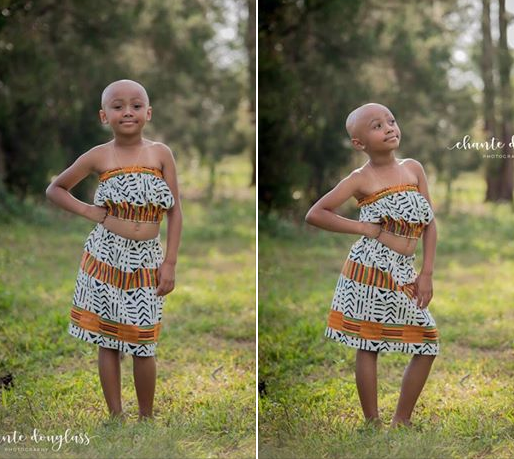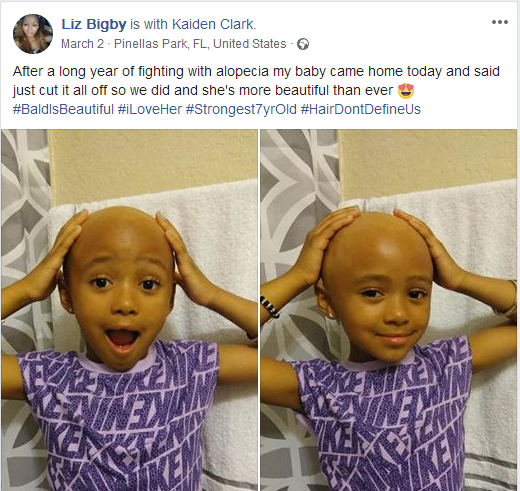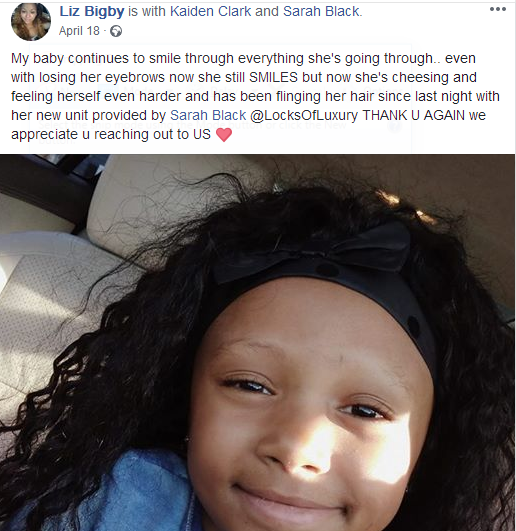Expository! 7-Year-Old Kaiden Clark Has Alopecia And Here Are The Signs Of The Disease You May Have Been Ignoring

7-year-old Kaiden Clark didn’t care that she had to be bald. In fact, at such a young age, she embraced the dramatic change to her appearance. Shaving her hair off was necessary, but she didn’t feel any less beautiful when it was gone.
In August 2016, Clark was diagnosed with Alopecia. According to her mother, Liz Servedio, Clark’s doctors initially thought she had ringworm.
Clark’s hair loss continued despite medication, so the Pinellas, Florida, family visited the dermatologist who made the call.
Clark tried to treat the Alopecia with specialized shampoo and lotion but within six months, the hair around her perimeter had vanished. Headbands and scarves weren’t enough to address the condition so she made a brave decision.
“She didn’t care,” Servedio, 37, wrote on Facebook. She wanted to cut it off.”
READ ALSO: ”Beauty is Beyond Skin”- Suicidal Grandmother, 37, Embraces Her Rare Skin Condition
And in February, 2018, she did and the photos of her new look went viral. Servedio posted the photos of Clark’s bald head, and the outpouring of support flooded. The picture drew more than 32,000 reactions and 13,000 shares on Facebook.
Servedio, who has four other children between the ages of 18 years to 6 months, has long, curly hair and it is amazing that Clark, who has recently toyed around with hair unit, hasn’t once mentioned her mother’s hair since her own hair was cut. Servedio said her baby girl loves being bald.
Clark launched the campaign B.A.B.E- Bald and Beautiful Everyday. And the family has continued to receive positive messages after the photos went viral.
“The support is awesome,” Servedio said. “She’s loving it to this day. She’s still receiving gifts and has lots of positive people in her messages. The message she sends is you’re beautiful regardless of any condition life throws at you.
“It doesn’t matter what’s on the outside — only what’s on the inside.”
Despite all she’s been through and even losing her eyebrows, Clark still wears a smile, anytime, any day.
”My baby continues to smile through everything she’s going through.. even with losing her eyebrows now she still SMILES but now she’s cheesing and feeling herself even harder and has been flinging her hair since last night with her new unit provided by Sarah Black @LocksOfLuxury THANK U AGAIN we appreciate you reaching out to US
❤.”
If you’ve seen a lot of extra hair on your pillow, brush, or shower drain, or you’ve noticed odd little bald spots in the mirror, you might have an autoimmune disorder called alopecia areata.
And when you have an autoimmune disease, your immune system attacks your own body. With alopecia areata, it’s the hair follicles that are attacked. This causes the hair to come out, often in clumps the size and shape of a quarter. The amount of hair loss is different in everyone. Some people lose it only in a few spots. Others lose a lot.
Here are some key points about alopecia areata, according to an article by the MedicalNewsToday.com
- One in five people with alopecia areata also has a family member who has experienced the condition.
- Alopecia areata often develops suddenly, over the course of just a few days.
- There is little scientific evidence that alopecia areata is caused by stress.
- People with alopecia areata who have only a few patches of hair loss often experience a spontaneous, full recovery, without the need for treatment.
- There is no cure for alopecia areata.
There is currently no cure for alopecia areata, although there are some forms of treatment that can be suggested by doctors to help hair re-grow quicker.
The most common form of alopecia areata treatment is the use of corticosteroids, powerful anti-inflammatory drugs that can suppress the immune system. These are mostly commonly administered through local injections, topical ointment application, or orally.
Other medications that can be prescribed that either promote hair growth or affect the immune system include Minoxidil, Anthralin, SADBE, and DPCP.
Although some of these may help with the re-growth of hair, they cannot prevent the formation of new bald patches.
Alopecia areata does not directly make people sick, nor is it contagious. It can, however, be difficult to adapt to emotionally. For many people, alopecia areata is a traumatic disease that warrants treatment addressing the emotional aspect of hair loss, as well as the hair loss itself.
Photo credit: Facebook/Instagram Liz







